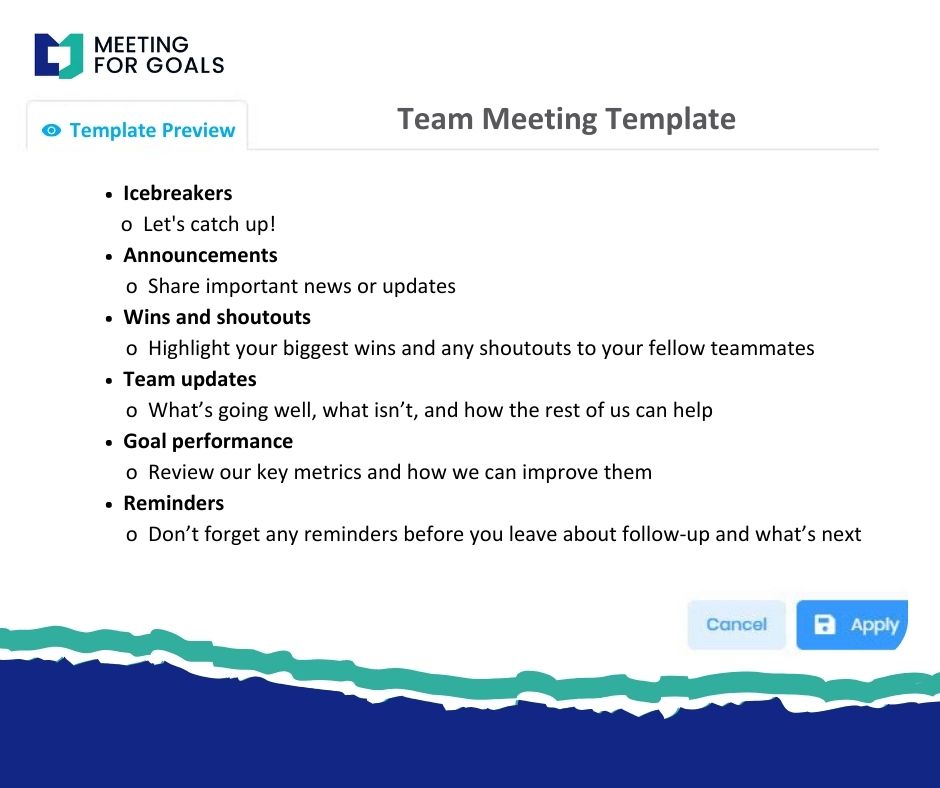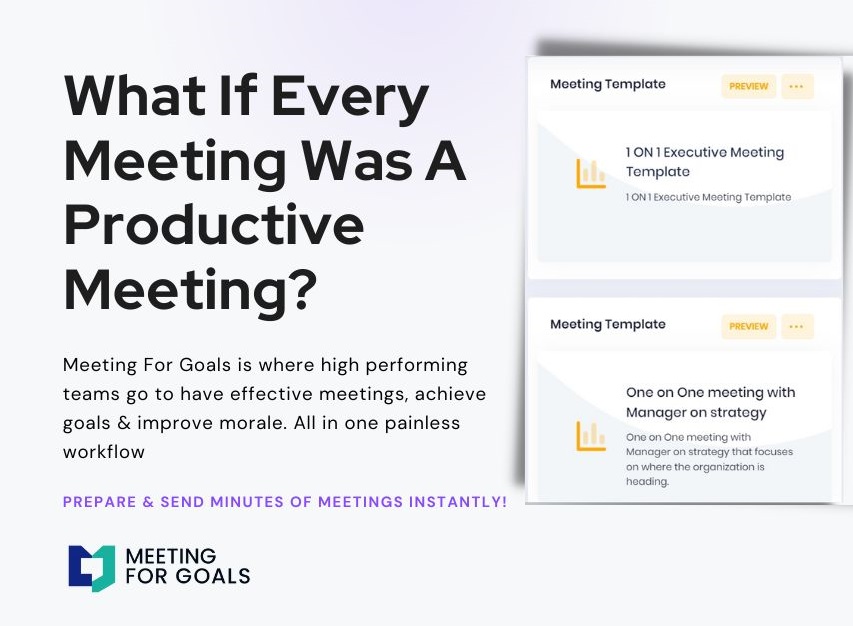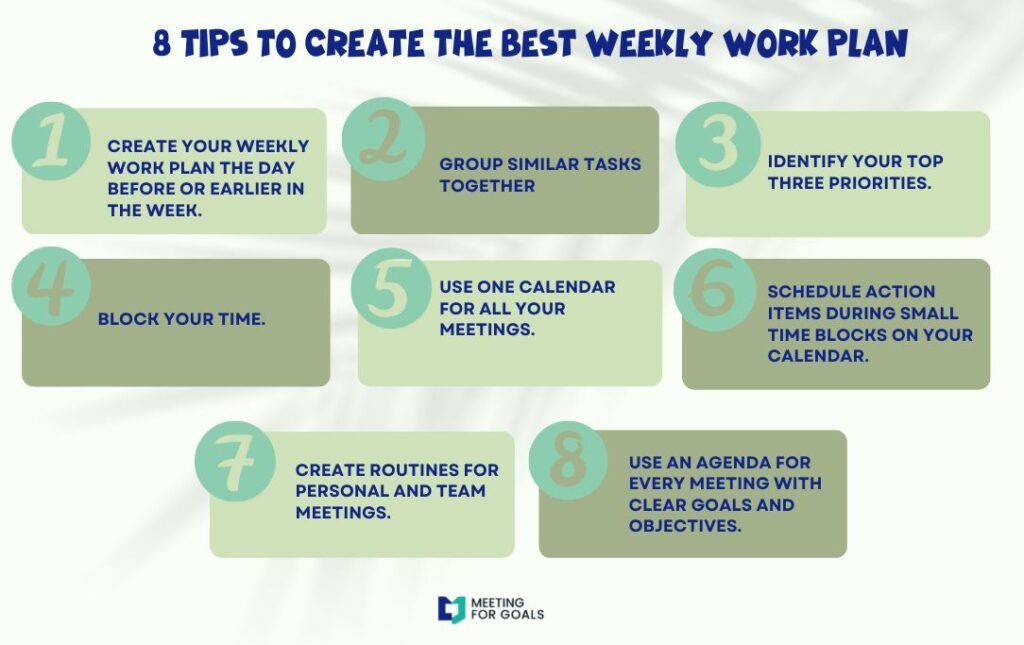What Are the Features of Management? How Effective Meeting Management Drives Team Success
I. Introduction
Management is the backbone of a thriving business. It’s what turns ideas into action and strategy into measurable results. For companies with 40–70 employees, especially those led by directors, VPs, and C-suite executives, strong management practices ensure that teams stay aligned, goals are met, and resources are maximized.
But there’s one often-overlooked factor that can make or break your management efforts: meetings.
Let’s be honest—most meetings aren’t productive. They often lack focus, drag on too long, and don’t lead to clear outcomes. That’s where Meeting For Goals brings real value. Our meeting management software is purpose-built for high-performing teams that want to make meetings count. It helps align discussions with company goals, assign responsibilities in real time, and improve team accountability.
Whether you’re a VP looking to streamline operations or a CEO aiming to boost team productivity, this guide will walk you through the four core features of management—planning, organizing, leading, and controlling. We’ll also show how effective meeting management can elevate each one. Lastly, we’ll explain how Meeting For Goals can help you create meetings that actually move the needle.
Ready to take your management game to the next level? Start by exploring our free meeting templates at https://meetingforgoals.com/meeting_templates and sign up at https://app.meetingforgoals.com/TenantRegistration/Register to see how our tools can work for your team.
2 Minute Video
Watch a 2 minute demo of our meeting management software in action
II. Planning
Planning is the first and most essential feature of management. It’s where everything begins. Without a solid plan, even the most talented teams can lose direction.
Planning involves:
- Setting clear, realistic goals
- Outlining strategies to reach those goals
- Allocating resources wisely
- Anticipating potential challenges and preparing solutions
For executives managing mid-sized teams, planning is the bridge between vision and execution. But planning doesn’t happen in a vacuum—it often starts in meetings.
With Meeting For Goals, planning becomes more than just talk. It becomes structured, actionable, and measurable.
- Goal-Oriented Agendas
Every productive meeting starts with a clear purpose. Our platform allows you to create agendas that are directly tied to company objectives. This ensures that every conversation supports your broader strategy. - Timeline Integration
Planning without deadlines is just wishful thinking. With our built-in timeline tools, you can assign deadlines to action items right within the meeting. This keeps your team on track and accountable. - Real-Time Role Assignment
Who’s doing what? Meeting For Goals lets you assign roles and responsibilities during the meeting itself. No more guessing who’s responsible for follow-ups. - Recurring Planning Sessions
Need to check in weekly or monthly? Set up recurring meetings with templated agendas to make planning a consistent part of your workflow. - Collaborative Planning
Planning shouldn’t be top-down. Our platform encourages team input, making plans more realistic and increasing buy-in from everyone involved.
For additional insights into strategic planning, Harvard Business Review offers a helpful guide on the importance of agile planning in dynamic business environments.
When planning is done right—and supported by the right tools—it sets your team up for success. With Meeting For Goals, you turn strategy into action and meetings into planning powerhouses.
Adding an Agenda
How to add an agenda instantly on Meeting For Goals
III. Organizing
Once the plan is in place, it’s time to organize your team and resources to make that plan happen. Organization is about structure, clarity, and efficiency.
Key aspects of organizing include:
- Defining team roles
- Structuring workflows
- Allocating resources effectively
- Establishing communication channels
Disorganized teams struggle with duplicated work, missed deadlines, and poor communication. That’s why organization is so critical—and why Meeting For Goals is built to support it.
- Structured Agendas
Use our customizable meeting templates to ensure your meetings follow a logical flow. This helps your team stay focused and creates consistency across departments. You can find a variety of templates tailored to different business needs at https://meetingforgoals.com/meeting_templates. - Task Delegation
Assign tasks directly in the meeting. Everyone leaves knowing exactly what they’re responsible for—and by when. No more post-meeting confusion. - Resource Visibility
Our dashboard shows who’s working on what and when. This helps you balance workloads and prevent burnout. - Centralized Documentation
All meeting notes, decisions, and action items are stored in one place. This makes it easy to review past discussions and onboard new team members quickly. - Seamless Integrations
Meeting For Goals connects with your existing tools—like Slack, Microsoft Teams, and project management platforms—so your organizational structure stays intact across all systems. - Cross-Functional Collaboration
Organizing isn’t just about internal teams. Our software supports interdepartmental collaboration, helping departments work together more effectively.
Well-organized teams work smarter, not harder. And with Meeting For Goals, you can build the kind of structure that drives real results.
IV. Leading
Leadership is about more than giving orders. It’s about inspiring people, guiding them through challenges, and creating a shared sense of purpose.
The leadership function includes:
- Motivating team members
- Communicating vision and goals
- Facilitating collaboration and decision-making
- Building trust and morale
Meetings are where leadership is most visible. They’re where decisions are made, feedback is given, and culture is shaped. Meeting For Goals empowers leaders to make the most of these moments.
- Decision-Making Frameworks
Use our platform’s built-in frameworks to guide your team through complex decisions. This makes discussions more productive and outcomes more effective. - Real-Time Feedback
Collect feedback during or after meetings to gauge team sentiment. This helps you adjust your leadership approach and improve team dynamics. - Communication Tools
Use built-in messaging, note-taking, and task assignment tools to ensure your message is heard and understood. - Recognition and Morale Boosting
Celebrate wins during meetings. Highlight completed tasks and team achievements to keep morale high. - Conflict Management
Meetings can surface disagreements. Our structured format helps you manage these moments constructively, focusing on solutions rather than blame. - Empowerment Through Clarity
When team members know what’s expected of them and feel heard, they’re more engaged. Meeting For Goals helps you lead with clarity and empathy.
For more on leadership best practices, check out this article from Forbes on how effective leaders build trust and accountability in their teams.
Leadership isn’t about control—it’s about influence. With Meeting For Goals, you can lead meetings that energize your team and drive results.
V. Controlling
Controlling doesn’t mean micromanaging. It means tracking progress, evaluating performance, and making adjustments to stay on course.
The controlling function includes:
- Monitoring goals and KPIs
- Evaluating team and individual performance
- Making course corrections
- Ensuring alignment with company strategy
Without control, even the best plans can fall apart. Meeting For Goals provides the tools you need to stay informed and responsive.
- Performance Dashboards
Our real-time dashboards show how teams are progressing on their goals. You can spot bottlenecks before they become problems. - Follow-Up Reports
After every meeting, you get a report that includes task assignments, deadlines, and accountability checkpoints. This ensures that what’s discussed actually gets done. - Accountability Tracking
Track who completed what—and when. This makes performance reviews and project evaluations easier and more objective. - Continuous Feedback
Regular check-ins and progress reviews are built into the platform. This keeps your team agile and aligned. - Historical Data
All meeting records are archived and searchable. This is essential for audits, compliance, and strategic planning. - KPI Integration
You can link meeting goals to broader business KPIs, ensuring that every meeting supports your company’s strategic direction.
Controlling isn’t about breathing down your team’s neck—it’s about giving them the structure and feedback they need to succeed. Meeting For Goals makes it easy to stay in control without being overbearing.
VI. Conclusion
Effective management isn’t just a checklist—it’s a mindset. It’s about planning with purpose, organizing for efficiency, leading with empathy, and controlling with insight.
And here’s the truth: none of these functions work well without effective meetings.
Meetings are where ideas are shared, decisions are made, and progress is tracked. But too often, they’re disorganized, unproductive, and frustrating. That’s where Meeting For Goals changes the game.
With our meeting management software, you can:
- Align meetings with strategic goals
- Assign tasks in real time
- Track performance and accountability
- Improve team morale and engagement
For executives managing teams of 40–70 people, the stakes are high. You need to make sure every meeting drives value. Every team member needs to be aligned. And every strategic initiative must stay on track.
Meeting For Goals helps you do all of that—and more.
Ready to experience the difference? Sign up today at https://app.meetingforgoals.com/TenantRegistration/Register and start transforming your meetings into engines of productivity.
Want to see what great meetings look like? Browse our free meeting templates at https://meetingforgoals.com/meeting_templates.
And for more insights on how to improve your team’s performance through smarter meetings, visit https://meetingforgoals.com.
Because when your meetings work, your management works. And when your management works, your team succeeds.



